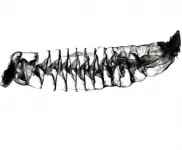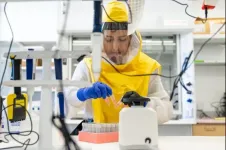(Press-News.org) Durham, Toronto and Princeton Universities have teamed up with NASA and the Canadian Space Agency to build a new kind of astronomical telescope. SuperBIT flies above 99.5% of the Earth's atmosphere, carried by a helium balloon the size of a football stadium. The telescope will make its operational debut next April and when deployed should obtain high-resolution images rivalling those of the Hubble Space Telescope. Mohamed Shaaban, a PhD student at the University of Toronto, will describe SuperBIT in his talk today (Wednesday 21 July) at the online RAS National Astronomy Meeting (NAM 2021).
Light from a distant galaxy can travel for billions of years to reach our telescopes. In the final fraction of a second, the light has to pass through the Earth's swirling, turbulent atmosphere. Our view of the universe becomes blurred. Observatories on the ground are built at high altitude sites to overcome some of this, but until now only placing a telescope in space escapes the effect of the atmosphere.
The Superpressure Balloon-borne Imaging Telescope (or SuperBIT) has a 0.5 metre diameter mirror and is carried to 40km altitude by a helium balloon with a volume of 532,000 cubic metres, about the size of a football stadium.
Its final test flight in 2019 demonstrated extraordinary pointing stability, with variation of less than one thirty-six thousandth of a degree for more than an hour. This should enable a telescope to obtain images as sharp as those from the Hubble Space Telescope.
Nobody has done this before, not only because it is exceedingly difficult, but also because balloons could stay aloft for only a few nights: too short for an ambitious experiment. However, NASA recently developed 'superpressure' balloons able to contain helium for months. SuperBIT is scheduled to launch on the next long duration balloon, from Wanaka, New Zealand, in April. Carried by seasonally stable winds, it will circumnavigate the Earth several times - imaging the sky all night, then using solar panels to recharge its batteries during the day.
With a budget for construction and operation for the first telescope of US$5 million (£3.62 million), SuperBIT cost almost 1000 times less than a similar satellite. Not only are balloons cheaper than rocket fuel, but the ability to return the payload to Earth and relaunch it means that its design has been tweaked and improved over several test flights. Satellites must work first time, so typically have (phenomenally expensive) redundancy, and decade-old technology that had to be space-qualified by the previous mission. Modern digital cameras improve every year - so the development team bought the cutting-edge camera for SuperBIT's latest test flight a few weeks before launch. This space telescope will continue to be upgradable, or have new instruments on every future flight.
In the longer term, the Hubble Space Telescope will not be repaired again when it inevitably fails. For 20 years after that, ESA/NASA missions will enable imaging only at infrared wavelengths (like the James Webb Space Telescope due to launch this autumn), or a single optical band (like the Euclid observatory due to launch next year).
By then SuperBIT will be the only facility in the world capable of high-resolution multicolour optical and ultraviolet observations. The team already has funding to design an upgrade from SuperBIT's 0.5 metre aperture telescope to 1.5 metres (the maximum carrying capacity of the balloon is a telescope with a mirror about 2 metres across). Boosting light gathering power tenfold, combined with its wider angle lens and more megapixels, will make this larger instrument even better than Hubble. The cheap cost even makes it possible to have a fleet of space telescopes offering time to astronomers around the world.
"New balloon technology makes visiting space cheap, easy, and environmentally friendly," said Shaaban. "SuperBIT can be continually reconfigured and upgraded, but its first mission will watch the largest particle accelerators in the Universe: collisions between clusters of galaxies."
The science goal for the 2022 flight is to measure the properties of dark matter particles. Although dark matter is invisible, astronomers map the way it bends rays of light, a technique known as gravitational lensing. SuperBIT will test whether dark matter slows down during collisions. No particle colliders on Earth can accelerate dark matter, but this is a key signature predicted by theories that might explain recent observations of weirdly behaving muons.
"Cavemen could smash rocks together, to see what they're made of," added Prof. Richard Massey of Durham University. "SuperBIT is looking for the crunch of dark matter. It's the same experiment, you just need a space telescope to see it."
INFORMATION:
CHICAGO --- A woman's heart health before she becomes pregnant is strongly related to her likelihood of experiencing a complication during her pregnancy or labor, reports a new Northwestern Medicine study.
The study examined the presence of four cardiovascular risk factors in women before they became pregnant: smoking, unhealthy body weight, hypertension and diabetes. With the presence of each additional risk factor, the likelihood that the woman would experience an adverse pregnancy outcome got increasingly higher. Those adverse outcomes include maternal intensive care unit (ICU) admission, preterm birth, low birthweight and fetal ...
Contrary to what popular media portrays, we actually don't know much about what sharks eat. Even less is known about how they digest their food, and the role they play in the larger ocean ecosystem.
For more than a century, researchers have relied on flat sketches of sharks' digestive systems to discern how they function -- and how what they eat and excrete impacts other species in the ocean. Now, researchers have produced a series of high-resolution, 3D scans of intestines from nearly three dozen shark species that will advance the understanding of how sharks eat and digest their food.
"It's high time ...
Being more physically active and spending fewer hours per day sitting watching TV is linked to a substantially lower risk of developing obstructive sleep apnoea (OSA), according to new research published in the European Respiratory Journal [1]. It is the first study to simultaneously evaluate physical activity and sedentary behaviour in relation to OSA risk.
OSA is a condition where breathing stops and starts many times during sleep. It reduces oxygen levels in the blood and common symptoms include snoring, disrupted sleep and feeling excessively tired. ...
Study offers first global estimates of the number of children who experienced the death of a parent, grandparent, or primary caregiver from COVID-19.
Researchers estimated figures based on COVID-19 mortality data from March 2020 through April 2021, and national fertility statistics for 21 countries, and extrapolated findings to produce global estimates.
Findings suggest 1 million children have lost a parent, 1.1 million have lost a parent or custodial grandparent, and more than 1.5 million have lost a parent, custodial grandparent, or other secondary familial caregiver from COVID-19.
Authors call for urgent investments in services to support children who have lost their parents and caregivers.
An estimated ...
New research published in Anaesthesia (a journal of the Association of Anaesthetists) by researchers from the University of Bristol can help to improve the efficiency of surgery and help tackle the growing backlog of surgery caused by the COVID-19 pandemic. During the pandemic, the number of patients waiting for routine surgery in the UK has almost doubled with more than 5.3 million people awaiting surgery including more than 300,000 waiting more than a year.
A contributory factor is that COVID-19 precautions have led to many operating theatres working at 75-50% of normal working efficiency. Staff working in operating theatres have been required to take special precautions at the start and end of operations to allow viral particles ...
More than 1.5 million children around the world are estimated to have lost at least one parent, custodial grandparent, or grandparent who lived with them due to death related to COVID-19 during the first 14 months of the pandemic, according to a study published today in The Lancet. The study highlights orphanhood as an urgent and overlooked consequence of the pandemic and emphasizes that providing evidence-based psychosocial and economic support to children who have lost a caregiver must be a key part of responding to the pandemic.
The analysis used mortality and fertility data to model rates of COVID-19-associated orphanhood (death of one or both parents) and deaths of custodial and co-residing grandparents (ages 60-84) from March 1, 2020 to April 30, 2021, across 21 countries. This study ...
Metabolic bone diseases, including osteoporosis, when bones lose their mass and become so fragile that they could be damaged while sneezing or under little stress, are called the silent epidemic of the 21st century. A person does not even know about his illness before the first symptom - it can be a fracture of the spine or the neck of the hip. According to statistics, every third woman and every fifth man after 50 have osteoporosis. Thus, it is promising to search for and obtain substances and materials for implants that have osteoinductive properties and are capable of initiating the processes of transformation of stem cells into bone.
Certain trace elements, such as calcium and magnesium, influence the processes of bone regeneration ...
In the early days of the pandemic, scientists at Virginia Tech created a COVID-19 testing laboratory and novel test for the virus from scratch.
They not only developed a test in-house that avoided the reagent supply shortages that hampered testing efforts nationwide, but also used 3D-engineered supplies and stable storage media, enabling samples to be transported to rural sites in Virginia without the need for constant refrigeration.
This novel protocol for transforming a research laboratory into a testing operation capable of processing more than 130,000 ...
Spider silk is said to be one of the strongest, toughest materials on the Earth. Now engineers at Washington University in St. Louis have designed amyloid silk hybrid proteins and produced them in engineered bacteria. The resulting fibers are stronger and tougher than some natural spider silks.
Their research was published in the journal ACS Nano.
To be precise, the artificial silk -- dubbed "polymeric amyloid" fiber -- was not technically produced by researchers, but by bacteria that were genetically engineered in the lab of Fuzhong Zhang, a professor ...
ITHACA, N.Y. - Small-scale. Short-lived. All digital. Out of public view. That's how a new form of collective worker resistance is unfolding in China's app-based food delivery economy, new Cornell University research finds.
Though highly fragmented and not always successful, "mini-strikes" by small groups of food couriers - conducted via WeChat - reflect a new form of leverage, suggest Chuxuan "Victoria" Liu and Eli Friedman, associate professor in the ILR School.
Food couriers are able to maintain complete physical invisibility, and each individual worker can 'strike' from anywhere, they write.
The scholars interviewed couriers, in-person and online, who delivered food for Ele.me, an Alibaba-owned company that controlled ...



